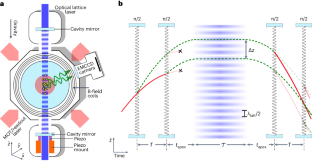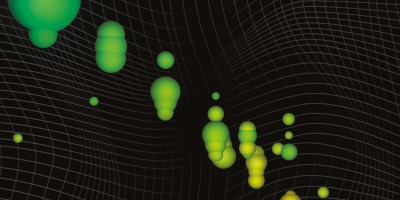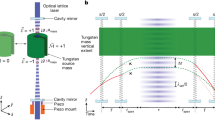Abstract
In quantum metrology and quantum simulation, a coherent non-classical state must be manipulated before unwanted interactions with the environment lead to decoherence. In atom interferometry, the non-classical state is a spatial superposition, where each atom coexists in multiple locations as a collection of phase-coherent partial wavepackets. These states enable precise measurements in fundamental physics and inertial sensing. However, atom interferometers usually use atomic fountains, where the available interrogation time is limited to around 3 s for a 10 m fountain. Here we realize an atom interferometer with a spatial superposition state that is maintained for as long as 70 s. We analyse the theoretical and experimental limits to coherence arising from collective dephasing of the atomic ensemble. This reveals that the decoherence rate slows down markedly at hold times that exceed tens of seconds. These gains in coherence may enable gravimetry measurements, searches for fifth forces or fundamental probes into the non-classical nature of gravity.



Similar content being viewed by others
Data availability
All data presented in this paper are available via Zenodo at https://doi.org/10.5281/zenodo.7187202 (ref. 43).
Code availability
All code used in this paper is available upon reasonable request.
References
Marti, G. E. et al. Imaging optical frequencies with 100 μHz precision and 1.1 μm resolution. Phys. Rev. Lett. 120, 103201 (2018).
Ohmae, N. et al. Transportable strontium optical lattice clocks operated outside laboratory at the level of 10−18 uncertainty. Adv. Quantum Technol. 4, 2100015 (2021).
Van Camp, M. et al. Geophysics from terrestrial time-variable gravity measurements. Rev. Geophys. 55, 938–992 (2017).
Hu, Z. K. et al. Demonstration of an ultrahigh-sensitivity atom-interferometry absolute gravimeter. Phys. Rev. A 88, 043610 (2013).
Stray, B. et al. Quantum sensing for gravity cartography. Nature 602, 590–594 (2022).
Carney, D., Müller, H. & Taylor, J. M. Using an atom interferometer to infer gravitational entanglement generation. PRX Quant. 2, 030330 (2021).
Hohensee, M. A., Estey, B., Hamilton, P., Zeilinger, A. & Müller, H. Force-free gravitational redshift: proposed gravitational Aharonov–Bohm experiment. Phys. Rev. Lett. 108, 230404 (2012).
Bose, S. et al. Spin entanglement witness for quantum gravity. Phys. Rev. Lett. 119, 240401 (2017).
Marletto, C. & Vedral, V. Gravitationally induced entanglement between two massive particles is sufficient evidence of quantum effects in gravity. Phys. Rev. Lett. 119, 240402 (2017).
Jaffe, M. et al. Testing sub-gravitational forces on atoms from a miniature in-vacuum source mass. Nat. Phys. 13, 938–942 (2017).
Sabulsky, D. O. et al. Experiment to detect dark energy forces using atom interferometry. Phys. Rev. Lett. 123, 061102 (2019).
Dickerson, S. M., Hogan, J. M., Sugarbaker, A., Johnson, D. M. S. & Kasevich, M. A. Multiaxis inertial sensing with long-time point source atom interferometry. Phys. Rev. Lett. 111, 83001 (2013).
Canuel, B. et al. Exploring gravity with the MIGA large scale atom interferometer. Sci Rep. 8, 14064 (2018).
Zhan, M.-S. et al. ZAIGA: Zhaoshan long-baseline atom interferometer gravitation antenna. Int. J. Mod. Phys. D 29, 1940005 (2019).
Badurina, L. et al. AION: an atom interferometer observatory and network. J. Cosmol. Astropart. Phys. 2020, 011 (2020).
Abe, M. et al. Matter-wave Atomic Gradiometer Interferometric Sensor (MAGIS-100). Quantum Sci. Technol. 6, 044003 (2021).
Becker, D. et al. Space-borne Bose–Einstein condensation for precision interferometry. Nature 562, 391–395 (2018).
Lachmann, M. D. et al. Ultracold atom interferometry in space. Nat. Commun. 12, 1317 (2021).
Barrett, B. et al. Dual matter-wave inertial sensors in weightlessness. Nat. Commun. 7, 13786 (2016).
Deppner, C. et al. Collective-mode enhanced matter-wave optics. Phys. Rev. Lett. 127, 100401 (2021).
Aveline, D. C. et al. Observation of Bose–Einstein condensates in an Earth-orbiting research lab. Nature 582, 193–197 (2020).
Frye, K. et al. The Bose–Einstein condensate and cold atom laboratory. EPJ Quantum Technol. 8, 1 (2021).
Cladé, P. et al. A promising method for the measurement of the local acceleration of gravity using Bloch oscillations of ultracold atoms in a vertical standing wave. EPL. 71, 730–736 (2005).
Charrière, R., Cadoret, M., Zahzam, N., Bidel, Y. & Bresson, A. Local gravity measurement with the combination of atom interferometry and Bloch oscillations. Phys. Rev. A 85, 013639 (2012).
Hilico, A., Solaro, C., Zhou, M. K., Lopez, M. & Pereira Dos Santos, F. Contrast decay in a trapped-atom interferometer. Phys. Rev. A 91, 053616 (2015).
Zhang, X., Del Aguila, R. P., Mazzoni, T., Poli, N. & Tino, G. M. Trapped-atom interferometer with ultracold Sr atoms. Phys. Rev. A 94, 043608 (2016).
Xu, V. et al. Probing gravity by holding atoms for 20 seconds. Science 366, 745–749 (2019).
Mitchell, J. T. On Systematics and Their Mitigation in MAGIS-100 Atomic Interferometer Experiment to Explore the Dark Sector and Early Universe. PhD thesis, Northern Illinois Univ. (2020).
Lisdat, C., Winfred, J. S. R. V., Middelmann, T., Riehle, F. & Sterr, U. Collisional losses, decoherence, and frequency shifts in optical lattice clocks with bosons. Phys. Rev. Lett. 103, 090801 (2009).
Kristensen, S. L., Jaffe, M., Xu, V., Panda, C. D. & Müller, H. Raman transitions driven by phase-modulated light in a cavity atom interferometer. Phys. Rev. A 103, 023715 (2021).
Storey, P. & Cohen-Tannoudji, C. The Feynman path integral approach to atomic interferometry. A tutorial. J. Phys. II France 4, 1999–2027 (1994).
Hogan, J. M., Johnson, D. M. S. & Kasevich, M. A. Light-pulse atom interferometry. In Proc. of the International School of Physics ‘Enrico Fermi’ Vol. 168 (eds Arimondo, E. et al.) 411–447 (IOS, 2009).
Lerner, L. A demonstration of decoherence for beginners. Am. J. Phys. 85, 870–872 (2017).
Overstreet, C., Asenbaum, P., Curti, J., Kim, M. & Kasevich, M. A. Observation of a gravitational Aharonov–Bohm effect. Science 375, 226–229 (2022).
Treutlein, P., Chung, K. Y. & Chu, S. High-brightness atom source for atomic fountains. Phys. Rev. A 63, 51401 (2001).
Zi, F. et al. Laser frequency stabilization by combining modulation transfer and frequency modulation spectroscopy. Appl. Opt. 56, 2649–2652 (2017).
Jaffe, M., Xu, V., Haslinger, P., Müller, H. & Hamilton, P. Efficient adiabatic spin-dependent kicks in an atom interferometer. Phys. Rev. Lett. 121, 40402 (2018).
Thommen, Q., Garreau, J. C. & Zehnlé, V. Theoretical analysis of quantum dynamics in one-dimensional lattices: Wannier-Stark description. Phys. Rev. A 65, 053406 (2002).
Poli, N. et al. Precision measurement of gravity with cold atoms in an optical lattice and comparison with a classical gravimeter. Phys. Rev. Lett. 106, 038501 (2011).
Gustavsson, M. et al. Control of interaction-induced dephasing of bloch oscillations. Phys. Rev. Lett. 100, 080404 (2008).
Alauze, X., Bonnin, A., Solaro, C. & Dos Santos, F. P. A trapped ultracold atom force sensor with a μm-scale spatial resolution. New J. Phys. 20, 083014 (2018).
Cladé, P. & Bloch, P. C. Bloch oscillations in atom interferometry. Riv. Nuovo Cim. 38, 173–207 (2015).
Panda C. D. et al. Quantum metrology by one-minute interrogation of a coherent atomic spatial superposition. Zenodo https://doi.org/10.5281/zenodo.7187202 (2022).
Acknowledgements
We thank J. Axelrod and A. Reynoso, for experimental assistance; J. Lopez for technical support; L. Clark, D. Carney, N. Gaaloul, M. Jaffe, P. Haslinger, Z. Pagel, G. Premawardhana, J. Roth, A. Singh and J. Taylor for valuable discussions. This material is based on work supported by National Science Foundation grants 1708160 and 2208029 (H.M.), Department of Defense Office of Naval Research grant N00014-20-1-2656 (H.M.) and Jet Propulsion Laboratory (JPL) grants 1659506 and 1669913 (H.M.).
Author information
Authors and Affiliations
Contributions
C.D.P., J.E., M.T. and M.C. built the apparatus and collected measurements. C.D.P. analysed the data. V.X. contributed to building the apparatus and initial investigations into the source of decoherence. C.D.P. and H.M. wrote the original draft. H.M. conceptualized and supervised the experiment. All authors contributed to the review and editing of the manuscript.
Corresponding authors
Ethics declarations
Competing interests
The authors declare no competing interests.
Peer review
Peer review information
Nature Physics thanks the anonymous reviewers for their contribution to the peer review of this work.
Additional information
Publisher’s note Springer Nature remains neutral with regard to jurisdictional claims in published maps and institutional affiliations.
Extended data
Extended Data Fig. 1 Atoms load into integer multiples of the lattice period.
a, Fourier spectral decomposition components of the measured fringes as a function of separation. Yellow represents a higher power density at the specific fringe frequency. b, fringe data when the initial wavepacket separation equals 7.5 lattice sites and fit (solid line) to a sum of two sine functions with frequencies corresponding to separations of 7 and 8 lattice sites. This data suggests that the lattice enacts a second beam splitter, such that the partial atomic wavepacket loads evenly into adjacent lattice sites with 7 and 8 lattice site separations.
Extended Data Fig. 2 Measured interferometer fringe frequency vs scan parameter.
a, fringe frequency from propagation, ωprop, obtained by scanning the hold time τ. b, fringe frequency from laser interactions, ωL, obtained by scanning the pulse separation T. Error bars correspond to 1σ (68%) Gaussian confidence intervals. Red lines correspond to the expected analytical fringe frequency as shown by equations (9) and (10). c, Contrast loss as a function of separation time, T. The fitted interferometer contrast varies as a function of T with a fast sinusoidal component given by lattice spacing times the recoil velocity, λlatt/2·vr. In addition, the contrast decay curve exhibits a smaller amplitude (4% typically) sinusoidal component with periodicity given by the least common multiple of the lattice laser and tracer laser wavelengths, λlatt and λtracer, which is due to dephasing from the interference of the lattice and tracer lasers. The red line fits the data using free parameters for the amplitudes of the exponential decay, amplitude of the higher frequency sinusoidal function and the amplitude of the lower frequency variation.
Extended Data Fig. 3 Noise and sensitivity.
a, Measured atom number, N, as a function of hold time, τ. This dataset was taken with trap depth U0 ≈ 12 Er. The solid line shows a fit to a decaying exponential. b, Sensitivity and standard quantum limit noise. The measured acceleration sensitivity within one second of measurement time (\(\delta g/g/\sqrt{{\rm{Hz}}}\)) is shown as dots. Values corresponding to the estimated standard quantum limit (shot) noise are calculated from the measured contrast and atom numbers and shown as solid lines.
Extended Data Fig. 4 Simulations of the t-test statistic, \(\hat{{C}}/{{\sigma }}_{\hat{C}}\).
a. Histogram of the distribution of \(\hat{C}/{\sigma }_{\hat{C}}\) for 1000 simulated fringes with zero contrast C = 0. b. Cumulative distribution functions (cdf) for \(\hat{C}/{\sigma }_{\hat{C}}\), shown for varying levels of simulation added noise (blue – compatible with experiment imaging and shot noise, yellow-10 times larger, green-10 times smaller).
Extended Data Fig. 5 Loading fractions.
Experimental data showing fractions of atoms remaining after loading and 1 second of hold time as a function of initial number, shown vs a, global tilt angle and b, trap depth, U0. Experimental data is shown by blue dots with error bars corresponding to 1σ (68% confidence) Gaussian intervals, and simulation results are in green.
Extended Data Fig. 6 Phase shifts due to differential motion between the atomic wavepacket in the top and bottom lattice sites.
The atomic wavepacket (wavy line on top of grey disk) is split into an equal superposition of two partial wavepackets (wavy lines on top of purple and orange disks). The partial wavepackets are loaded into lattice sites (blue ovals) that are spatially separated by a distance of Δz. Solid lines show representative atom trajectories in the two lattice sites, which are both initially loaded at position {x, y}i and start with phase ϕ0. Survival probabilities due to Landau-Zener tunneling are shown by the trajectories color gradients and range from 1 (green) to 0 (red). Time-dependent tilts cause the position of the lower lattice site to oscillate with a differential amplitude relative to the top in the transverse plane, atilt, leading to a displaced trajectory of the bottom atom partial wavepacket with final position \({\{x,y\}}_{f}^{t}\ne {\{x,y\}}_{f}^{b}\) (difference Δ{x, y}sep) and propagation phase difference \({\phi }_{f}^{t}\ne {\phi }_{f}^{b}\). The rightmost panels show the two main dephasing mechanisms, due to differential propagation phase, \(\Delta {\phi }_{\text{latt}}^{\text{prop}}\), and separation phase, \(\Delta {\phi }_{\text{latt}}^{\text{sep}}\).
Extended Data Fig. 7 Simulated contrast decay.
Contrast vs hold time τ for four separate configurations: standard level of vibrations, with vibrations reduced to zero, with tunneling reduced to zero, and with atom position and velocity distributions widths reduced 5-fold. All simulations used a wavepacket separation of \(\Delta z=1.9 \, \mu \text{m}\) and a peak trap depth of U0 = 7 Er. The dashed lines represent exponential fits to the τ < 20 s region of the data. The bands represent 95 % confidence intervals.
Supplementary information
Supplementary Video 1
Sequence of fluorescence images showing dynamics of the spherically symmetric atom cloud loading into a TEM01 mode of the optical cavity. The yellow and red colors represent regions of space with high atom density. The atoms that have good overlap with the cavity get loaded and initially oscillate (period 150 ms) before eventually (after 300–400 ms) filling the available cavity mode trap volume.
Rights and permissions
Springer Nature or its licensor (e.g. a society or other partner) holds exclusive rights to this article under a publishing agreement with the author(s) or other rightsholder(s); author self-archiving of the accepted manuscript version of this article is solely governed by the terms of such publishing agreement and applicable law.
About this article
Cite this article
Panda, C.D., Tao, M., Egelhoff, J. et al. Coherence limits in lattice atom interferometry at the one-minute scale. Nat. Phys. (2024). https://doi.org/10.1038/s41567-024-02518-9
Received:
Accepted:
Published:
DOI: https://doi.org/10.1038/s41567-024-02518-9
- Springer Nature Limited





